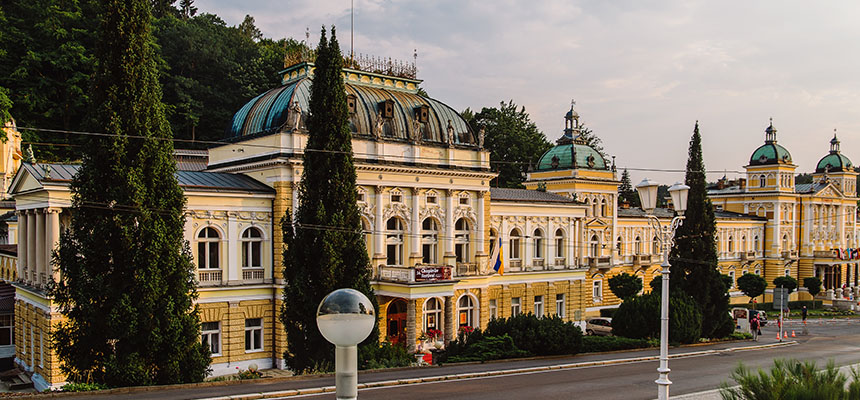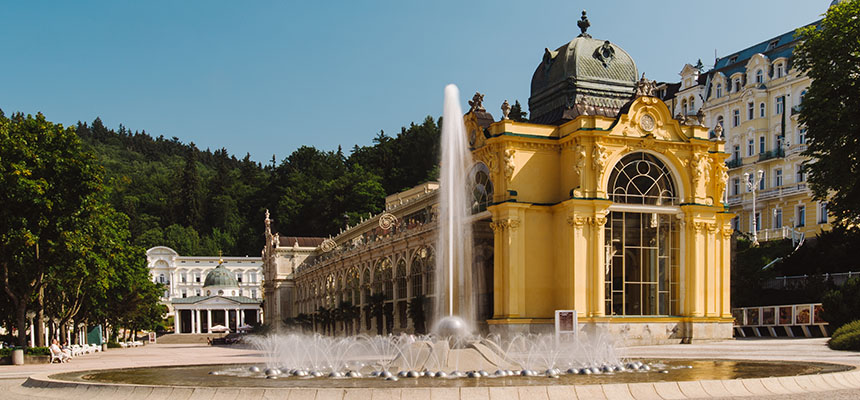
There is no doubt that Marianske Lazne is literally the crown jewel of the Czech balneology. Therefore is totally achieveable something as exceptional as entry in the UNESCO list. Towns and places in the whole world are literally upping each others in effort to get on the list. There is no wonder because there possibly exists no greater prestige and individual items do not become the modern “wonders of the world” for no reason.
Marianske Lazne have been designated UNESCO World Heritage
Since 24.7.2021 is Marianske Lazne a part of the UNESCO World Heritage. After 11 years of negotiation the city came to a successful end. Marianske Lazne, Karlovy Vary and Frantiskovy Lazne are among 11 European spa towns added to the UNESCO list as Great Spas of Europe. Another spa places are:
- Germany – Baden-Baden, Bad Ems a Bad Kissingen;
- Belgium - Spa;
- France - Vichy;
- Italy - Montecatini Terme;
- Austria - Baden u Vídně;
- UK - City of Bath.
Why Marianske Lazne?
Marianske Lazne forms a part of the so-called spa triangle along with Karlovy Vary and Frantiskovy Lazne. This area is specific for the largest occurrence of thermal and mineral springs in the country. If the major spa towns are to be on the UNESCO World Heritage List, Marianske Lazne cannot be absent. It is one of the biggest and most important spa towns in our country. The history of the local springs reaches as far back as the 16th century and the local settlement was declared public spa in 1818. The town saw the greatest boom of balneology in the 19th century. Nowadays it retains its high prestige among domestic and foreign guests until this day.
The prerequisites for the nomination of Marianske Lazne are simply indisputable and therefore there is nothing left but to firmly believe that the town will justify its position in this important list.

As regards the World Heritage List, countries often try hard to get the biggest number of items possible on the list, aiming to increase the potential of such sites. This entry is a great honour, adding a sense of uniqueness and excellence compared the rest of the world, no matter whether it is a historical sight or a region.
It is due to the internationally recognized value, prestige, and worldwide reputation that the locations become the focus of attention of those who wish to help at difficult moments and situations. They demonstrate the huge transnational and also civil solidarity and desire to help the cultural and natural heritage in the times of need. The registration in the UNESCO list results, apart from prestige, also in many other benefits including an increase in tourism and a simplified approach to varied subsidies.
As for the number of sights entered in the Unesco World Heritage List, the Czech Republic is quite unique. It already has 14 entries, which is double the average of all countries and some even deem the country a “UNESCO power”. In the event that Marianske Lazne succeeds in its nomination, it will stand alongside towns such as the Cesky Krumlov, Kutna Hora, Prague, or the Lednice-Valtice Area.
A couple of details from the project’s history
In November 2006, the Karlovy Vary Region ordered a professional assessment of historical centres of Karlovy Vary, Marianske Lazne, and Frantiskovy Lazne. This so-called small passport was submitted to the Ministry of Culture along with the application to include in the Indicative Sites List, according to which the Czech Republic was supposed to file nominations of the most important sights in the UNESCO World Heritage List, which happened the very same month.
The idea of transforming the national nomination in a serial transnational nomination was initiated in 2009, and in 2010 the National Heritage Institute prepared a comparative analysis of the world spa heritage. This helped to select other European spa towns that may appear in the future nomination. The official structure for preparing the nomination dossier was created in 2013. During 2015, expert documents for the decision on the final composition of the nomination were made and the following year a list of the spa towns selected was made.
Nomination of Marianske Lazne in the UNESCO list
Major European spa towns – this is the name of the category, in which the listed towns were included. The selection was made for those spas that contribute to spreading cultural influences related to balneology, even on the transnational scale. The Czech Republic coordinates this “campaign” but it is a joint activity of seven countries of Europe.
The preparation of the very motion for nomination is very complex and its creators make effort to carefully fine-tune all source documents. The issue is that if a motion is once dismissed, the locality cannot be nominated again. This is also one of the reasons why the whole matter has been lasting for several years. Vojtech Franta, the regional representative in Karlovy Vary who is in charge of UNESCO, even mentioned that it is the most complex nomination in history. This follows in particular from the fact that all participants from all towns and countries – mayors, expert groups, etc. must find common ground. All of them make great effort. Together they successfully achieved the goal - UNESCO heritage status.
UNESCO in Brief
The United Nations Educational, Scientific and Cultural Organization has its seat in Paris and it is one of 14 international UN expert organizations. At present, the UNESCO has 195 member and 9 associated member states.
The greatest attention is paid by UNESCO to education. Apart from the fact that it is the only UN organization dealing with fundamental and social sciences, it is an important pioneer in the field of environmental protection. The general public is widely acquainted with activities related to protecting tangible as well as intangible world cultural heritage, however, the authority of the UNESCO also includes the rapidly developing area of communication and informatics.
UNESCO is a very important worldwide organization. Apart from other, in the course of its existence it initiated over 30 multilateral conventions in the field of copyright protection, cultural monument protection, and the validation of university diplomas.

